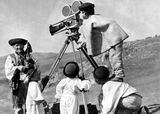
Treasures from the European Film Archives 2003 / Zem spieva / Czechoslovakia 1933
In the poetic documentary The Earth Sings Plicka brought together outlines of ideas and his existing footage, and rounded them out with new scenes, thereby creating a film poem drawing on the richness of Slovak folk culture. The basic plotline focuses on country life: the perpetual natural cycle beginning with the end of winter and the rise of spring, continuing on to autumn with its grape harvest as the last of the sun’s gifts.

After the founding of Czechoslovakia in 1918, ethnographic activities of the League for the Advancement of the Slovak Nation (Matica slovenská) extended to include film. Credit for this goes to musicologist Karel Plicka (1894-1987) who worked for the League as of 1923 collecting folk music. In addition to taking down songs and photographing national folk costumes, he began to film folk celebrations and costumes with a Pathé camera. Commenting on Plicka’s debut Za slovenským ľudom (In Search of the Slovak Nation, 1928 – much of which has been lost), a period critic highlighted its value as a documentary. His second feature, Po horách, po dolách (Over Hill and Dale, 1929), also remained within the limits of the specialized documentary. When Plicka got hold of a sound camera at the beginning of the 1930s he shot his key work Zem spieva (1933). Here, the enthusiastic folklorist displayed his knowledge of and personal familiarity with the chosen topic, but also introduced new aesthetic elements. In the poetic documentary Zem spieva he brought together outlines of ideas and his existing footage, and rounded them out with new scenes, thereby creating a film poem drawing on the richness of Slovak folk culture. The basic plotline focuses on country life: the perpetual natural cycle beginning with the end of winter and the rise of spring, continuing on to autumn with its grape harvest as the last of the sun’s gifts. The filmmaker chose a particular poetics for the individual scenes as they occur in the various seasons of the year. Shots of Prague and Bratislava represent a prologue to the film, while children playing in the open air create an epilogue. The compiled material became the basis for creating the musical accompaniment; later, with editing tailored definitively to music recorded by František Škvor, they arrived at an aesthetically impressive unification of the pictorial and musical aspects of the work. Editing by Alexander Hackenschmied, a Czech documentarist inspired by his experience with the Russian avant-garde, influenced the finished product significantly. In spite of the fact that Zem spieva is a talkie, Plicka employed the use of graceful intertitles written by poet Ján Smrek. The film came about without a script, based on the filmmaker’s imagination of the whole, working it and making it more and more concrete as he went along. The original negative, however, was destroyed in a fire at Zlín Studios in 1944; two double negatives were made from an incomplete positive copy in 1945, and in 1983 a new recording of the original music was laid down. The film film was acknowledged more outside the country than in: along with Řeka (The River), Extase (Ecstasy) and Bouře nad Tatrami (Storm above the Tatras), it took the City of Venice Cup for Best Director at the second Biennale in 1934.
63 min / Black & white, 35 mm
Director Karel Plicka
/ Screenplay Karel Plicka
/ Dir. of Photography Karel Plicka
/ Music František Škvor
/ Editor Alexander Hackenschmied
/ Contact Slovenský filmový ústav / Slovak Film Institute
www: www.sfd.sfu.sk
Slovenský filmový ústav / Slovak Film Institute
Grösslingová 32, 811 09, Bratislava
Slovakia
Phone: +421 257 101 503
Fax: +421 252 963 461
E-mail: [email protected]

Viera Ďuricová
Film Institution Rep.
First-hand brews throughout the year.
Be among the first to learn about upcoming events and other news. We only send the newsletter when we have something to say.